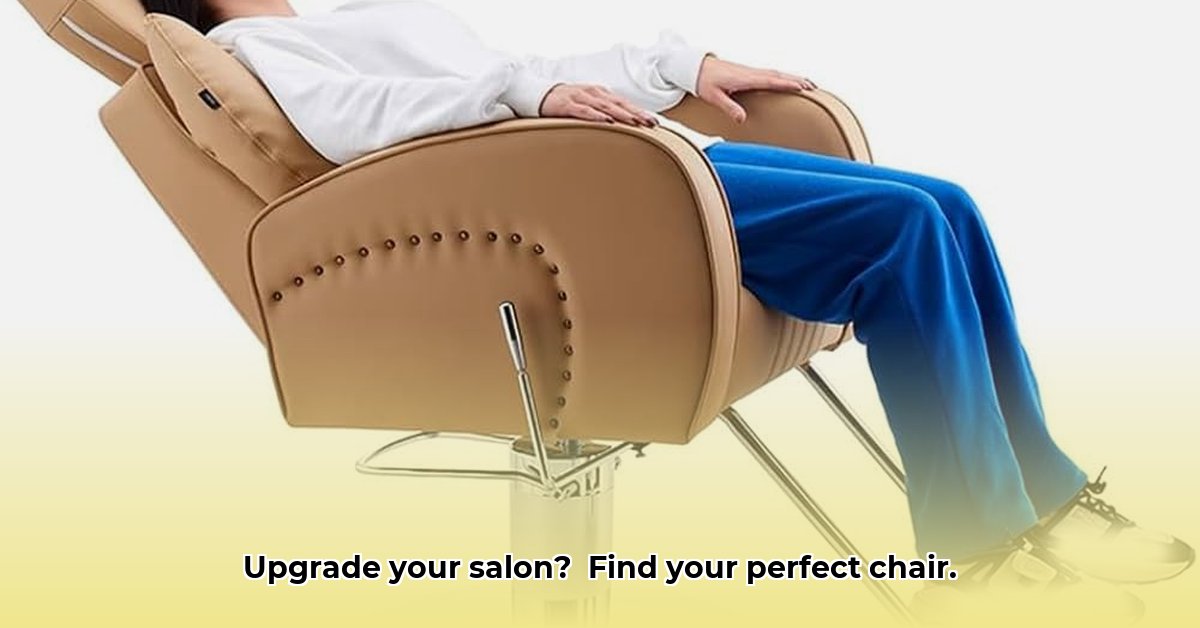Finding the perfect salon chair can feel like a puzzle, but it doesn’t have to be! A comfortable, stylish chair is key for happy clients and a productive workday. This guide breaks down everything you need to know about reclining salon chairs, from the fancy hydraulics to the essential materials. We’ll help you figure out what features matter most (like adjustability, cleanability, and weight capacity!), compare materials and their respective pros and cons and understand the importance of ergonomics. Whether you’re opening a brand-new salon, barber shop, or spa, or just upgrading your existing one, read on to find the perfect chair that fits your style and budget – and keeps your clients coming back for more. For even more options, check out these reclining salon chairs.
Reclining Salon Chairs: Your 2025 Comprehensive Guide
Navigating the vast selection of reclining salon chairs can be overwhelming. How do you pinpoint the ideal chair that delivers comfort, impressive durability, and elegant style, perfectly complementing your business needs and delighting your clients? This guide offers clarity, streamlining your selection process to ensure a choice that ticks all the boxes, enhances your workspace and elevates the client experience.
Key Features to Consider for Your Perfect Recliner
Let’s explore the features that transform ordinary salon chairs into thrones of comfort and efficiency, ensuring your business runs smoothly. The following details will directly impact both your client experience and the longevity of your investment for years to come.
1. Reclining Mechanisms: The Heart of Comfort and Functionality
The way your chair reclines significantly impacts both comfort and ease of use. You’ll encounter two main types:
- Hydraulic Recliners: Feature smooth, effortless adjustments with a simple foot pump or hand lever. They provide consistent, comfortable experiences and are generally more reliable in the long run.
- Manual Recliners: Typically cost less, but require more physical effort to adjust, often involving levers or ratcheting mechanisms. While this might be a budget-friendly option, carefully consider how often you’ll need to adjust the chair.
Pros and Cons:
| Feature | Hydraulic | Manual |
|---|---|---|
| Ease of Use | Effortless, smooth adjustment | Requires more physical effort |
| Cost | Generally more expensive | Generally less expensive |
| Durability | Typically more robust mechanisms available | Mechanism can wear out faster with frequent use |
| Maintenance | Minimal; occasional lubrication | May require more frequent adjustments and repairs |
2. Durability and Materials: Choosing the Right Stuff
The materials used significantly impact both the look and lifespan of your chair. Consider not only the upholstery, but also the frame, base and pump mechanism. Here’s a look at some of the most common choices:
- Leather: Leather is the epitome of luxury. It’s durable, looks stunning, and develops a rich patina over time. Ensure it’s genuine leather, as bonded or faux leather won’t have the same lifespan.
- Vinyl: Vinyl is a fantastic alternative to leather. It offers a wide array of colors and designs, is easy to clean, and is far more budget-friendly. Look for high-grade, stain resistant vinyl for optimal durability.
- High-Quality Fabrics: Consider durable upholstery fabrics designed for commercial use. These can offer a good balance between cost, durability, and aesthetic appeal. Look for stain-resistant, tightly woven, and easy-to-clean options. Microfiber is a popular choice due to its soft texture and resistance to wear.
3. Ergonomic Design: Comfort is King (and Queen!)
Client comfort is non-negotiable. Ergonomic design supports proper posture and minimizes strain on the client’s back, neck, and legs. Also consider the comfort of the stylist or technician who will be using the chair daily. Look for these key features:
- Adjustable Headrests: Allow clients to find the perfect neck support; removable headrests offer added versatility.
- Adjustable Footrests: Enable clients to fully relax and extend their legs; look for sturdy, easily adjustable footrests.
- Lumbar Support: Provides crucial support for the lower back, crucial for preventing discomfort during longer sessions.
- Seat Depth and Width: Ensure the chair’s dimensions accommodate a variety of body types; wider seats are more inclusive.
- Armrests: Padded armrests add comfort and support.
Poor ergonomic design can lead to discomfort, fatigue, and even pain. It’s also crucial for the stylist’s well-being, preventing strain from constantly working with an improperly positioned client.
4. Style and Customization: Making a Statement That Represents Your Brand
Your salon chair isn’t just functional; it’s also a design element. Choose a chair that complements your salon’s brand and aesthetic. Consider the color palette, the style of the chair (modern, classic, etc.), and how well it integrates with your overall décor. Consider these styling elements:
- Color: Coordinate with your salon’s overall color scheme.
- Base Style: Round, square, or chrome bases offer different aesthetics.
- Stitching: Detailed stitching can add a touch of elegance.
- Shape: Sleek, modern lines or more traditional, curved shapes.
5. Extra Perks: Going the Extra Mile for Enhanced Client Satisfaction
Some chairs offer exciting extra features that elevate the client experience and set you apart from the competition:
- Integrated Massage: A built-in massage function adds a touch of luxury and pampering.
- Heated Seats: Perfect for adding an extra layer of comfort, especially in cooler climates.
- USB Charging Ports: Allow clients to charge their devices during their appointment.
- Antimicrobial Surfaces: These surfaces resist the growth of bacteria and other microorganisms, promoting hygiene.
6. Accessibility: Catering to All Clients with Inclusivity
Consider the needs of all your clients. A truly inclusive salon employs chairs that are accessible to individuals of varying abilities and body types. Look for features that promote easy access and provide comfortable seating for a broad range of physiques. Consider these accessibility features:
- Wide Seats: Accommodate clients of all sizes.
- Adjustable Height: Lower settings make it easier for clients to get in and out of the chair.
- Sturdy Armrests: Provide support for clients with mobility issues.
7. Weight Capacity: Ensuring Safety and Stability
Always check the weight capacity of the chair to ensure it can safely accommodate all clients. Exceeding the weight limit can damage the chair and pose a safety risk.
Budget: Setting Realistic Expectations and Maximizing Value
The prices of reclining salon chairs can range significantly, depending on the materials, features, and brand. Budget-friendly options might start around a few hundred dollars, while high-end chairs with all the bells and whistles can reach several thousand. Setting a realistic budget before you even start looking will save you time and frustration. Consider these budget factors:
- Upfront Cost: The initial purchase price of the chair.
- Long-Term Maintenance: Potential repair or replacement costs.
- Lifespan: How long the chair is expected to last.
- Warranty: A good warranty can protect your investment.
Top Reclining Salon Chairs: A Word of Caution and Advice
Because the market changes so rapidly, it’s impossible to provide a definitive “best” list. Product rankings change frequently. Instead, I suggest looking at multiple reputable review sites (such as industry publications and salon equipment suppliers), focusing specifically on your chosen budget and desired features. Customer reviews from verified buyers are your most valuable resource. Pay attention to comments about durability, comfort, and customer service.
Maintenance and Care: Keeping Your Chairs in Top Shape for Longevity
Regular cleaning and maintenance are key to extending the life of your salon chairs. Always follow the manufacturer’s recommended cleaning and care instructions. Regular cleaning not only extends the lifespan of the chair, it’s also crucial for maintaining hygiene in your salon. Consider these maintenance tips:
- Regular Cleaning: Wipe down the chair after each use with a mild disinfectant.
- Upholstery Care: Use appropriate cleaning products for the specific material (leather, vinyl, fabric).
- Lubrication: Lubricate moving parts (reclining mechanism, pump) regularly.
- Professional Maintenance: Schedule professional maintenance checks to identify and address potential issues early on.
Conclusion: The Right Chair Makes All the Difference to Level Up Your Salon
Choosing the right reclining salon chair is a significant investment. Investing the time to carefully consider the factors outlined above will ensure you select a chair that’s comfortable for your clients, durable for your business, and aesthetically pleasing for your salon’s design. The added comfort and enhanced client experience are worth the investment.
How to Choose the Most Ergonomic Reclining Salon Chair for Client Comfort and Stylist Well-being
Choosing a reclining salon chair that’s both comfortable and ergonomic is critical for client satisfaction and stylist health. Which key features should you focus on to optimize both client experience and the efficiency of your staff?
Key Takeaways:
- Client comfort is paramount, impacting client loyalty and salon reputation.
- Ergonomics are crucial for both clients and stylists, preventing discomfort and injury.
- Durability and ease of cleaning directly affect operational efficiency and longevity.
Reclining Mechanisms: The Heart of
- Glass Backsplash: Ideas For a Stylish Kitchen Update - December 2, 2025
- Glass On Tile: A Stylish Kitchen Backsplash Option - December 1, 2025
- Glass Tiles for Kitchen: Style and Durability Tips - November 30, 2025










